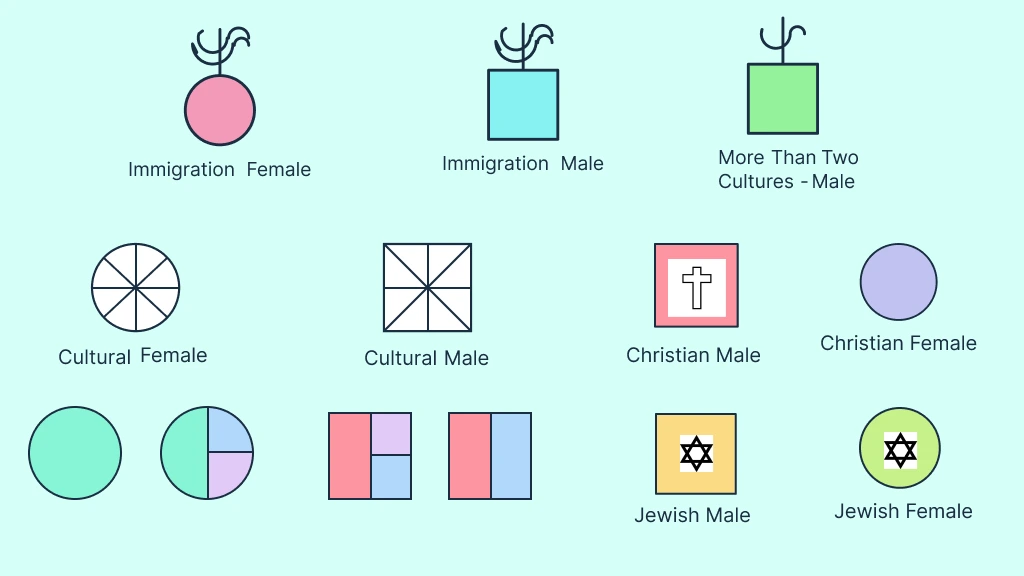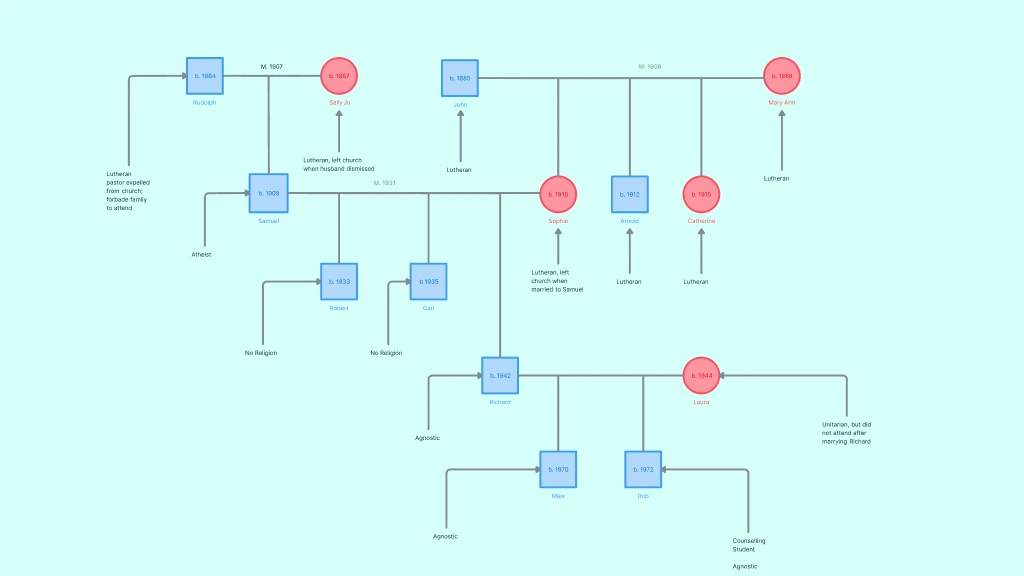What is a Cultural Genogram?
A cultural genogram is a visual family map incorporating heritage, migration routes, and cultural attributes alongside traditional lineage charts. It builds on standard genograms by adding layers for language retention, ceremonies, and customs across generations. Professionals apply cultural genograms in therapy to explore how heritage influences client behavior, in academic research to analyze migration and assimilation patterns, and in organizational diversity mapping to highlight workforce ancestry and tradition.
How to Make a Cultural Genogram Using Creately
Step 1: Open a Cultural Genogram Template
Before gathering data, start with a visual foundation. Add Creately’s genogram template to your workspace to help you map not only family relationships but also cultural factors like migration, language, education, and values. The template includes common genogram symbols, which you can customize to include cultural dimensions like traditions, belief systems, and language shifts.
Step 2: Collect and Organize Data
Gather materials that reflect your family’s cultural identity over time:
- Birth records and legal documents.
- Migration and immigration records.
- Educational certificates and academic achievements.
- Religious affiliations and practices.
- Languages spoken across generations.
- Oral histories passed down through storytelling.
Conduct interviews with family members to capture:
- Cultural values and belief systems.
- Traditions and rituals.
- Major cultural turning points or transitions.
Collect photographs and media from:
- Cultural celebrations (e.g., weddings, religious festivals).
- Graduation ceremonies and educational milestones.
- Family gatherings that reflect shared identity or heritage.
Attach documents, photos, and recordings directly to nodes using Creately’s file upload feature. Use comments to store interview insights and anecdotal stories.
Step 3: Choose and Customize Your Symbols
Use Creately’s built-in genogram symbols like squares for males, circles for females, and standard relationship lines to represent family structure. For cultural details, apply color coding, labels, and annotations directly to existing symbols to indicate elements like religion, language, migration, or education.

Tip: Include a legend on the canvas using existing shapes and text for clarity.
Step 4: Build the Genogram
Start mapping family members from the oldest generation at the top down to the youngest.
- Use built-in connectors to define key relationships like marriages, parent-child links, and sibling groups.
- Add cultural context by labeling individuals with religion, language, migration history, and education level. Apply Creately’s icons, color coding, and text annotations to visually represent cultural traits.
- Include notes for complex cultural narratives like interfaith marriages, immigration events, and language or cultural shifts across generations.
- Apply styled connectors (e.g., dashed or colored lines) to show emotional bonds and intergenerational dynamics.

Step 5: Collecting Feedback
Share your cultural genogram with extended family or cultural experts to validate accuracy and deepen the insights. Invite them to collaborate in real-time or asynchronously via a sharable link. Ask them to review whether the cultural elements you’ve highlighted resonate and if any traditions or events are missing.
Focus Feedback On:
- Symbol Accuracy: Are the cultural icons, colors, and markers clear and meaningful to others?
- Event Placement: Are the major cultural milestones represented chronologically and contextually?
Tip: Use inline comments to collect feedback on specific icons or segments.
Step 6. Iterating for Consensus
Use the feedback to revise and enrich your genogram. This may involve adjusting cultural classifications, adding missing narratives, or shifting event placements for clarity. Repeat this process until family members or collaborators feel it reflects a true representation of cultural identity and heritage. Use version history to manage multiple iterations without losing data. Once finalized, export the genogram in PDF, PNG, or shareable link format for wider distribution or archival.
Tip: Use tags or task checklists to track edits based on reviewer feedback.
Best Practices for Creating a Cultural Genogram
Keep It Simple and Focused
Avoid trying to represent every possible cultural detail at once. Instead, identify a few core themes or cultural traits you want to highlight such as migration, religion, or language use. Overloading your genogram with too much detail can make it confusing and detract from its purpose. Start with the most meaningful elements and expand over time if needed.
Avoid Cultural Stereotyping
When representing cultural traits, be careful not to reduce individuals or groups to generic symbols or assumptions. For example, don’t assume everyone from a certain background shares the same belief system or behavior. Use labels and icons to reflect actual, known traits and values shared within your family, and not generalized ideas about ethnicity, nationality, or religion.
Treat It as a Living Document
A cultural genogram is never truly “finished”. Families evolve, new stories surface, and interpretations of cultural identity shift. Revisit and update your genogram as needed, especially as you collect new information or involve additional family members. Using a platform like Creately allows you to keep the genogram editable, collaborative, and version-controlled.
Document Sources When Possible
If your genogram includes historical events, family migrations, or cultural affiliations based on oral histories, interviews, or documents, try to record your sources. This helps maintain transparency, adds credibility, and preserves context for others who may view or contribute to the genogram later.
Respect Family Members’ Privacy
Be mindful of the information you include, especially when sharing the genogram publicly or with extended family. Some cultural, emotional, or relationship details may be sensitive. Always ask permission when including personal stories or identifying cultural attributes that could be private. Use initials, pseudonyms, or visual placeholders if full disclosure isn’t appropriate.
Free Cultural Genogram Templates
Helpful Resources for Making Cultural Genograms
Use this ready-made cultural genogram template to get started.
Learn the different ways to use cultural genograms to educate therapists.
Learn about the different types of genograms you can create.
FAQs about Creating Cultural Genograms
What is the difference between a regular genogram and a cultural genogram?
Is it okay to include sensitive information?
Only with consent. Be respectful of family members’ privacy and emotional boundaries. If you need to include sensitive cultural or relational data (e.g., divorce, interfaith tension), consider:
- Using pseudonyms.
- Marking those sections as private.
- Keeping a separate internal version for personal use.
What are the general guidelines for creating a genogram?
When creating a genogram, follow these key conventions:
- Males are positioned on the left and females on the right within each relationship pair.
- Same-generation individuals are connected with horizontal lines.
- Children are arranged from left to right in order of birth, with the oldest child first.
How do you make a cultural genogram culturally accurate?
- Interview family members for personal context.
- Avoid assumptions or stereotypes—use real, observed traits.
- Include notes or citations where information comes from oral histories or documents.
- Ask others to review your diagram and provide feedback.
Resources
Hardy, Kenneth V., and Tracey A. Laszloffy. “THE CULTURAL GENOGRAM: KEY to TRAINING CULTURALLY COMPETENT FAMILY THERAPISTS.” Journal of Marital and Family Therapy, vol. 21, no. 3, July 1995, pp. 227–237.
Warde, Bryan. “The Cultural Genogram: Enhancing the Cultural Competency of Social Work Students.” Social Work Education, vol. 31, no. 5, Aug. 2012, pp. 570–586, https://doi.org/10.1080/02615479.2011.593623.





